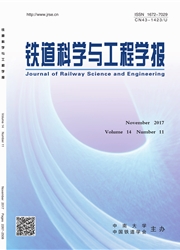

 中文摘要:
中文摘要:
针对TR08高速磁浮车辆运行中铝合金悬浮架弹性变形较大的问题,采用ANSYS建立了悬浮架有限元模型,并进行结构模态分析;为了提高悬浮架动力学数值计算效率,依据等效变形原则建立刚性悬浮架模型,计算等效弹簧参数。基于弹性和刚性悬浮架建立磁浮车辆整车动力学模型,对比分析了曲线通过时2种悬浮架模型动力学响应。计算结果表明:车辆以速度100,250和430km/h通过半径为2260m的曲线时,2种悬浮架模型铰点垂向位移计算值之差不超过0.5mm,悬浮间隙计算相对误差小于2%,悬浮架扭转角响应曲线基本重合,表明建立的等效刚性悬浮架模型是合理的;应用于整车动力学性能仿真时具有足够的计算精度,其计算效率远高于采用弹性模型时的计算效率,但弹性悬浮架模型能更准确、全面地模拟其弹性变形和振动响应。
 英文摘要:
英文摘要:
In order to calculate elastic deformations of the levitation chassis of TR08 maglev vehicle, a finite element model of the levitation chassis was established using ANSYS software, and modal analysis was carried out. The equiva- lent rigid model of the levitation chassis was also developed to improve calculation efficiency, and the equivalent spring parameters were calculated according to the same deformation principle. Thus two kinds of maglev vehicle models using the elastic or rigid levitation chassis were developed respectively to simulate and compare their dynamic curving response on the 2 260 m radium curve with the speed of 100, 250 and 430 km/h.The results show the vertical displace- ment differences of the joints between the rigid and elastic levitation chassis model are less than 0-5 mm, the relative calculation errors of the levitation gaps are less than 2 %, and time - history curves of the torsion responses are close superposition. It is concluded that the equivalent rigid model is reasonable and can meet the calculation accuracy required in maglev vehicle' dynamic simulation; moreover, its calculation efficiency is greatly higher than that of the elas- tic model. However the elastic chassis model can simulate deformations and vibration responses more completely and exactly.
 同期刊论文项目
同期刊论文项目
 同项目期刊论文
同项目期刊论文
 期刊信息
期刊信息
